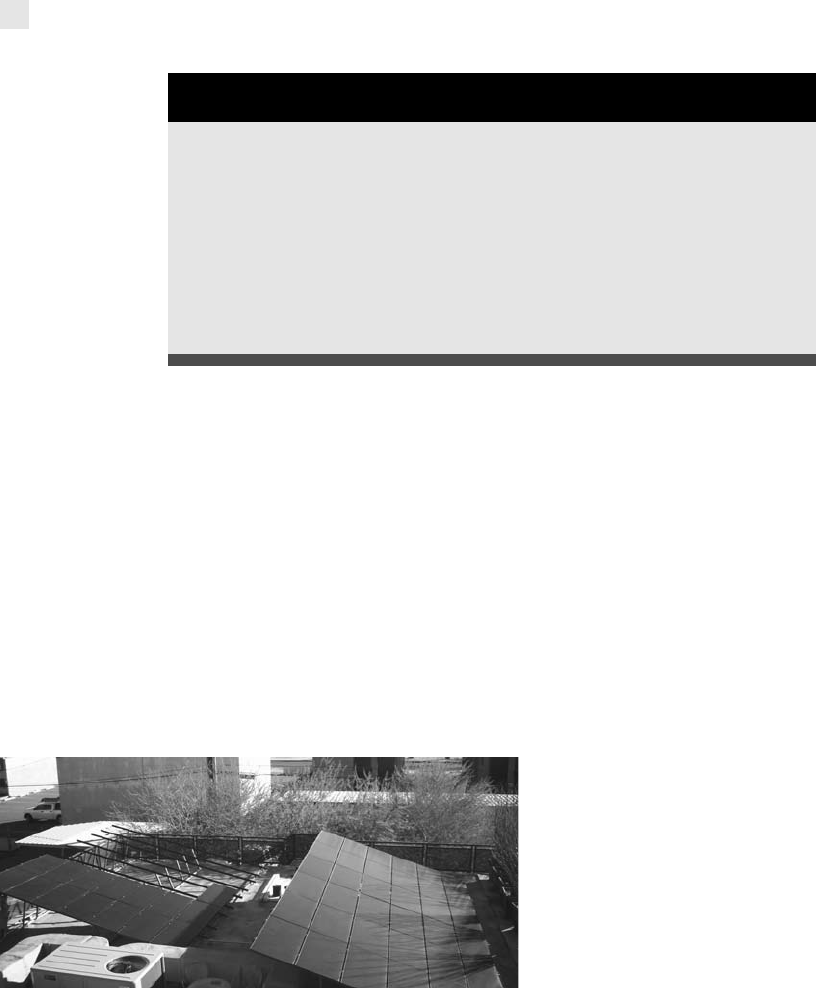
Shading and Shading Checklists
PV Array Configuration and System Concept
In a perfect world and with a perfect installation, PV arrays would always be
shade-free. The hours between 8 a.m. and 4 p.m. solar time would be best. The
sun between 9 a.m. and 3 p.m. is nearly full yet loses energy that could be other-
wise collected. PV modules have high output rates due to all the sun energy that is
available. However, not every place in North America has a window of full sun
that long. Some sites are not suitable for PV.
Shading is possible no matter where an array is placed. It can be small
amounts of shading from fallen leaves and bird droppings, or it can be from a
newly erected building or a tree
that grows big enough to eclipse
the array. Even minimal shading
diminishes energy output severely.
The impact of shading hinges
on certain considerations:
Goals
When you complete this chapter, you will be able to:
Understand shading and shading losses on PV modules.
Compare and contrast series and parallel connections.
Describe BOS components.
Say what the necessary steps in checklists are.
Differentiate types of generators and inverters used in PV power systems.
Describe the available options for mounting PV modules.
Shading is a problem, which is why this designer might have calculated
the shading for 8 a.m., noon, and 4 p.m. to space his rows without shading.
Even 9 a.m. to 3 p.m. would have picked up more energy if space were not
an issue. These panels in the shaded rack were adjusted after the fact at
some cost to the integrator.
Courtesy of PerfectPower, Inc.
Portion of shade on the
module and the total number
of shaded modules
Interaction between PV cell
and bypass diode
Amount of shading
Path of shading over time
PV module connections
Design of the inverter
140 ADVANCED PHOTOVOLTAIC INSTALLATIONS
Studies indicate that a 2 percent shade factor striking the array can cause a
12 percent loss of energy. This is substantial. If you do not understand how cells,
panels, and arrays work with an inverter, you will not be able to account for these
weaknesses.
You can avoid shading. Design around it in some instances. Reduce the
system size or relocate panels. This removes some or all of the loss from shading.
Array orientation can reduce the possibility of shading. For the best output,
PV arrays should face south. Placing the array facing south capitalizes on peak
sun hours before and after solar noon, providing the longest solar day. Optimal
system performance requires at least six hours, preferably eight hours, of shade-
free functioning in winter. However, a perfect south orientation may be hard
to attain.
The amount of solar energy available at a site is essentially equal in the
morning and afternoon if there is no shading interfering with the energy collec-
tion. However, during the summer, energy usage or load peaks later in the day.
You should take this into account in your design.
Some people seem to believe that there is more energy available in the afternoon
and that it may be better to face PV panels to the west. This is a myth that impacts
design and installation but is absolutely without foundation. Facing PV panels to the
west may result in an entire PV array that is shading itself in the morning.
Many in the utility industry would like PV designers and installers to take
their cues from utility and consumer needs as far as the time frame for peak
energy production. This is especially true for grid-tied PV systems. They would
like to have panels face west where systems would deliver more energy during the
electrical demand peak. This may serve the utility needs; however, PV systems
would collect less energy daily and annually. They would suffer additional voltage
loss and, therefore, energy loss from hotter panels.
However, even though a PV system reduces utility companies’ costs for capital
equipment and fuel, they are still unwilling to pay the customer for peak-hour pro-
duction by facing modules west or southwest to offset the customer’s energy losses
from doing so. Utilities encourage this practice to reduce their own investors’ costs.
Until utilities reimburse the customer for saving them money, you should
focus on maximizing the system output for the property and system owner.
That is why a detailed shading analysis is so important on the PV site. It is
rudimentary but critical for all PV professionals to understand the sun’s path and
its impact on system operation and performance.
Harvested sunshine is money. Losing it to shading, especially avoidable
shading, is stealing out of the customer’s pocket.
Shade calculation devices can help determine if any barriers in or around the
site will shadow the PV array during peak sun hours any day of the year. These
devices assess the shading on any location.
CHAPTER 7 PV Technology—Cells, Panels, Arrays, Balance of System, and Inverters 141
..................Content has been hidden....................
You can't read the all page of ebook, please click here login for view all page.
